Cylinder Block -- Disassembly |
| 1. INSPECT CONNECTING ROD THRUST CLEARANCE |
Using a dial indicator, measure the thrust clearance while moving the connecting rod back and forth.
- Standard thrust clearance:
- 0.15 to 0.55 mm (0.00591 to 0.0217 in.)
- Maximum thrust clearance:
- 0.70 mm (0.0276 in.)
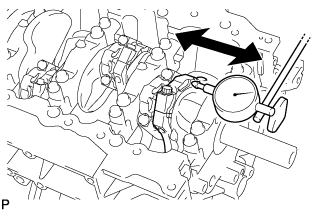 |
| 2. INSPECT CONNECTING ROD OIL CLEARANCE |
Check the matchmarks on the connecting rod and cap to ensure correct reassembly.
Remove the 2 connecting rod cap bolts.
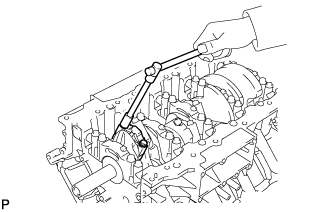 |
Using the 2 removed connecting rod cap bolts, remove the connecting rod cap and lower bearing by wiggling the connecting rod cap right and left.
- HINT:
- Keep the lower bearing and connecting rod cap together.
 |
Clean the crank pin and bearing.
Check the crank pin and bearing for pitting and scratches.
If the crank pin or bearing is damaged, replace the bearings. If necessary, replace the crankshaft.
Lay a strip of Plastigage across the crank pin.
Text in Illustration *1 Plastigage
 |
Check that the front mark of the connecting rod cap is facing forward.
Text in Illustration *1 Front Mark 
Front
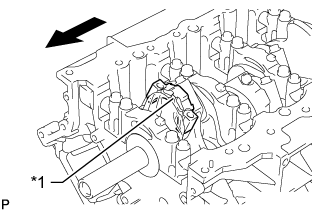 |
Apply a light coat of engine oil to the threads of the connecting rod cap bolts.
Install the connecting rod cap bolts.
- HINT:
- The cap bolts are tightened in 2 progressive steps.
Step 1:
Install and alternately tighten the bolts of each connecting rod cap in several steps.- Torque:
- 40 N*m{408 kgf*cm, 30 ft.*lbf}
Mark the front side of each connecting rod cap bolt with paint.
Step 2:
Tighten the cap bolts 90°.Check that the paint marks are now at a 90° angle to the front.
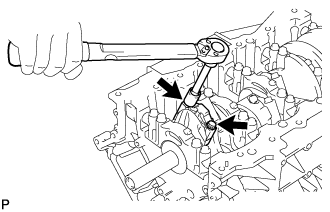 |
Remove the 2 connecting rod cap bolts.
 |
Using the 2 removed connecting rod cap bolts, remove the connecting rod cap and lower bearing by wiggling the connecting rod cap right and left.
- HINT:
- Keep the lower bearing and connecting rod cap together.
 |
Measure the Plastigage at its widest point.
- Standard oil clearance:
- 0.025 to 0.050 mm (0.000984 to 0.00197 in.)
- Maximum oil clearance:
- 0.070 mm (0.00276 in.)
If the oil clearance is more than the maximum, replace the bearings. If necessary, inspect the crankshaft.Text in Illustration *1 Plastigage *2 Number Mark *3 No. 1 Crankshaft Pin *4 No. 2 Crankshaft Pin *5 No. 3 Crankshaft Pin *6 No. 4 Crankshaft Pin - HINT:
- If replacing a bearing, replace it with one that has the same number as its respective connecting rod cap. Each bearing's standard thickness is indicated by a 1, 2, 3 or 4 mark on its surface.
- Select the correct bearing by adding together the number marks imprinted on the big end of the connecting rod and the crankshaft.
- Standard Bearing Chart:
Item Number Mark Connecting rod 1 2 1 2 3 2 3 4 3 4 Crankshaft 1 2 1 3 2 1 3 2 1 3 2 3 Use bearing 2 3 4 5 6 7
Connecting rod "1" + Crankshaft "2" = 3 (Use bearing "3")- Standard Sized Bearing Center Wall Thickness:
Item Specified Condition Mark 2 1.489 to 1.492 mm (0.0586 to 0.0587 in.) Mark 3 1.492 to 1.495 mm (0.0587 to 0.0589 in.) Mark 4 1.495 to 1.498 mm (0.0589 to 0.0590 in.) Mark 5 1.498 to 1.501 mm (0.0590 to 0.0591 in.) Mark 6 1.501 to 1.504 mm (0.0591 to 0.0592 in.) Mark 7 1.504 to 1.507 mm (0.0592 to 0.0593 in.)
- Standard Connecting Rod Big End Inside Diameter:
Item Specified Condition Mark 1 56.000 to 56.006 mm (2.20472 to 2.20496 in.) Mark 2 56.006 to 56.012 mm (2.20496 to 2.20519 in.) Mark 3 56.012 to 56.018 mm (2.20519 to 2.20543 in.) Mark 4 56.018 to 56.024 mm (2.20543 to 2.20566 in.)
- Standard Crankshaft Pin Diameter:
Item Specified Condition Mark 1 52.994 to 53.000 mm (2.08637 to 2.08661 in.) Mark 2 52.988 to 52.994 mm (2.08614 to 2.08637 in.) Mark 3 52.982 to 52.988 mm (2.08590 to 2.08614 in.)
 |
Completely remove the Plastigage.
Perform the inspection above for each cylinder.
| 3. REMOVE PISTON AND CONNECTING ROD |
Using a ridge reamer, remove all the carbon from the top of the cylinder.
Text in Illustration *1 Ridge Reamer
 |
Push out the piston with connecting rod and upper bearing through the top of the cylinder block.
- HINT:
- Keep the bearings, connecting rod and cap together.
- Arrange the piston and connecting rod assemblies in the correct order.
| 4. REMOVE CONNECTING ROD BEARING |
Remove the connecting rod bearings from the connecting rods and connecting rod caps.
- HINT:
- Arrange the removed parts in the correct order.
| 5. REMOVE PISTON RING SET |
Using a piston ring expander, remove the 2 compression rings.
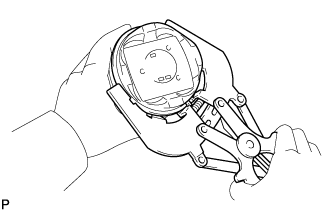 |
Remove the 2 side rails and oil ring (expander) by hand.
| 6. REMOVE PISTON WITH PIN SUB-ASSEMBLY |
Disconnect the connecting rod from the piston.
Using a screwdriver, pry out the 2 snap rings.
Gradually heat the piston to approximately 80°C (176°F).
Using a plastic-faced hammer and brass bar, lightly tap out the piston pin and remove the connecting rod.
- HINT:
- The piston and pin are a matched set.
- Arrange the removed parts in the correct order.

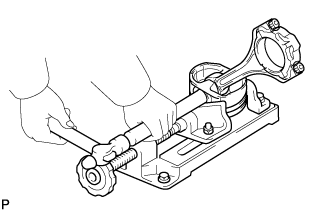
Clean the piston.
Using a gasket scraper, remove the carbon from the piston top.
Using a groove cleaning tool or broken ring, clean the piston ring grooves.
Using solvent and a brush, thoroughly clean the piston.
- NOTICE:
- Do not use a wire brush.


| 7. INSPECT CRANKSHAFT THRUST CLEARANCE |
Using a dial indicator, measure the thrust clearance while prying the crankshaft back and forth with a screwdriver.
- Standard thrust clearance:
- 0.020 to 0.220 mm (0.000787 to 0.00866 in.)
- Maximum thrust clearance:
- 0.30 mm (0.0118 in.)
- Standard thrust washer thickness:
- 2.44 to 2.49 mm (0.0961 to 0.0980 in.)
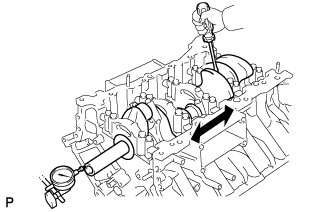 |
| 8. REMOVE CRANKSHAFT |
Uniformly loosen and remove the 10 bearing cap bolts and 10 seal washers in several steps in the sequence shown in the illustration.
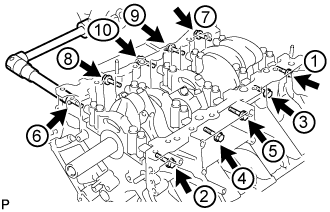 |
Uniformly loosen and remove the 20 bearing cap bolts in several steps in the sequence shown in the illustration.
 |
Using a screwdriver, slightly pry up the 5 main bearing caps.
Text in Illustration *1 Protective Tape *2 Cylinder Block *3 Bearing Cap *4 Joint Surface - NOTICE:
- Push up on the cap little by little, alternating between the right and left side until the cap can be removed.
- Be careful not to damage the joint surfaces of the cylinder block or bearing cap.
- HINT:
- Tape the screwdriver tip before use.
- Keep the lower bearing and crankshaft bearing cap together.
 |
Using 2 inside position main bearing cap bolts, loosen each main bearing cap by moving it forward and backward, and remove the 5 main bearing caps and 2 lower thrust washers (No. 3 crankshaft bearing cap only).
- HINT:
- Arrange the removed parts in the correct order.
Lift out the crankshaft.
| 9. REMOVE CRANKSHAFT BEARING |
Remove the crankshaft bearings from the bearing caps and cylinder block.
- HINT:
- Arrange the removed parts in the correct order.
| 10. REMOVE CRANKSHAFT THRUST WASHER SET |
Remove the thrust washer set from the cylinder block and No. 3 bearing cap.
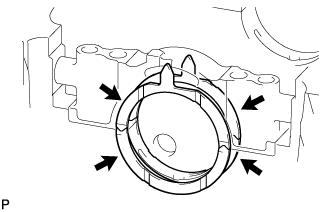 |
| 11. REMOVE NO. 1 OIL NOZZLE SUB-ASSEMBLY |
Using a 5 mm hexagon wrench, remove the 4 bolts and 4 No. 1 oil nozzles.
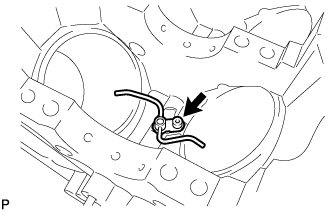 |
| 12. REMOVE STUD BOLT |
- NOTICE:
- If a stud bolt is deformed or its threads are damaged, replace it.